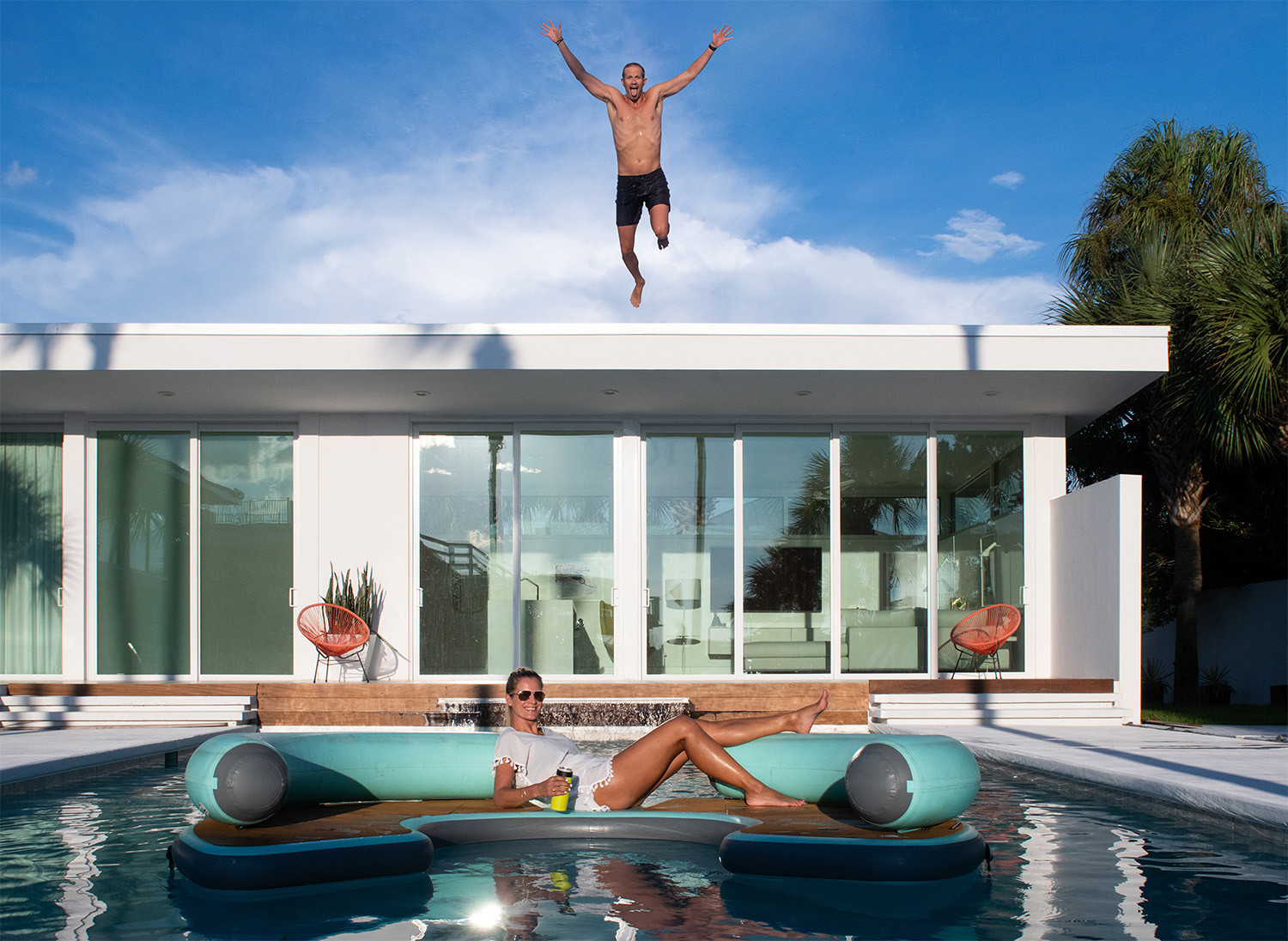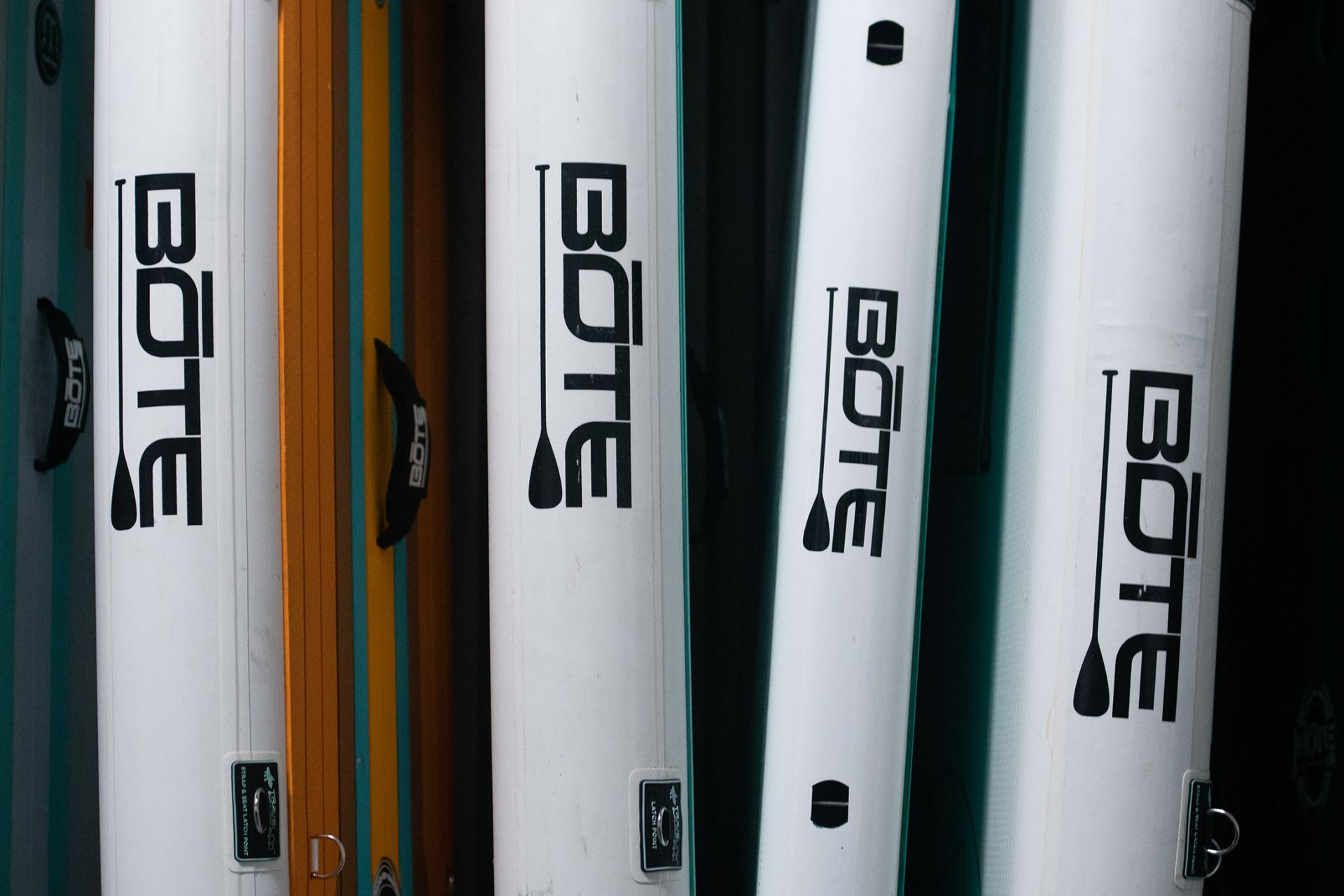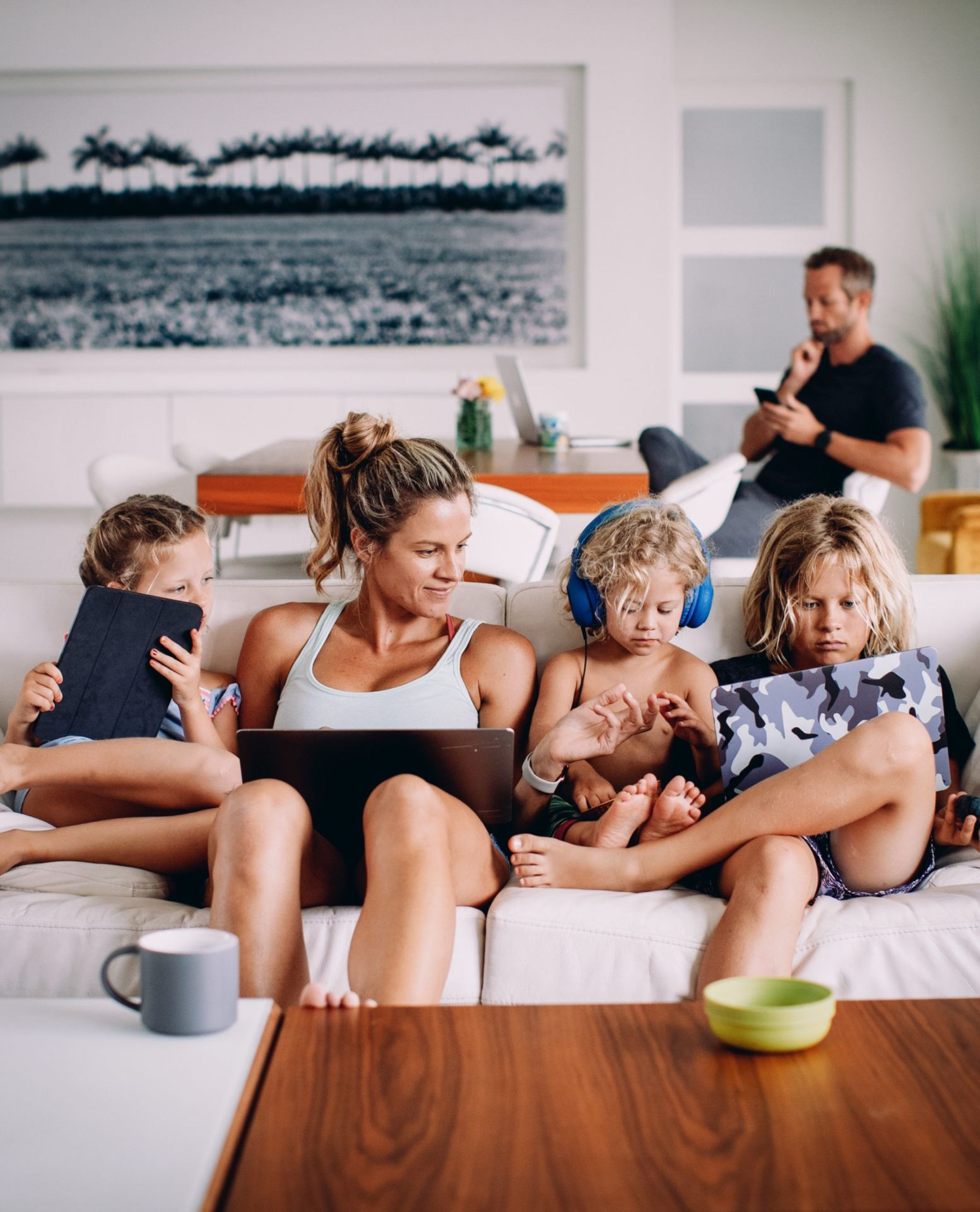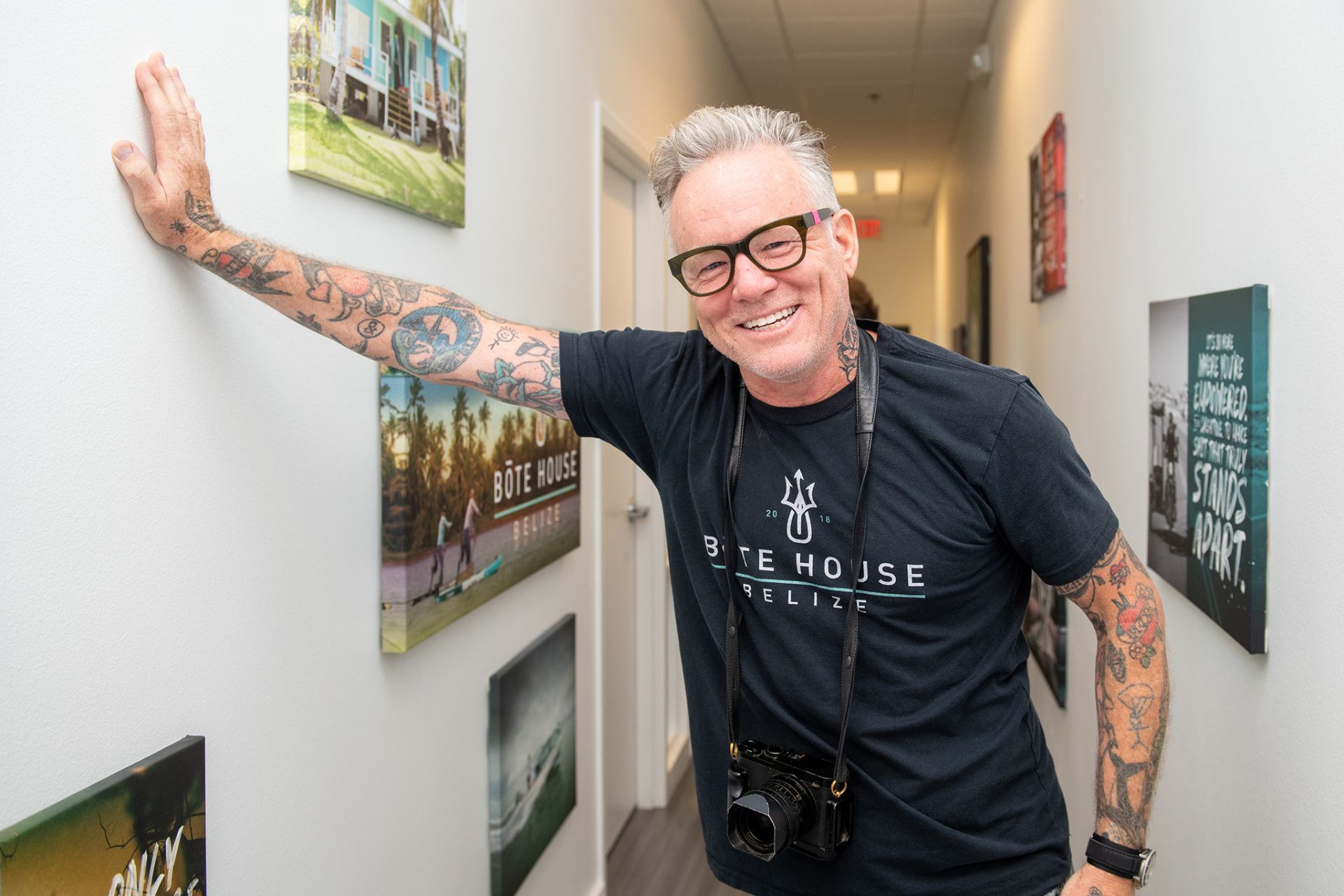Ambition, drive and a rock ‘n’ roll vision helped two Auburn graduates build a global outdoor lifestyle brand.
By Todd Deery ’90

Corey Cooper ’05 walks to the edge of the roof of his guest house and stares down at the pool below. His wife, Magda Cooper ’05, lounges on an inflatable dock and faces the poolside photographer, who is waiting to see what Corey will do. Will he jump in the pool? Corey looks again and inches closer, his toes touching the edge.
“This is what the company is like” he says.
In one quick move, Corey steps off the roof, into the air below. He jumps in.
Corey and Magda Cooper have always been jumping in. Jumping into their marriage and family. Jumping into solving impossible problems. Jumping into graduating early from Auburn and winning national championships in swimming.
For the last 13 years, they’ve spent every waking moment building BOTE, a global water lifestyle brand that mixes the couple’s rebel spirit with a relentless pursuit of quality and “badass” design.
What started in a storage unit below a Mellow Mushroom in Destin, Fla., has become a company with more than 70 domestic employees, 350 products and $100 million in annual sales.
We walk through a 110,000-square-foot warehouse packed with stand up paddleboards (SUPs), kayaks, coolers, inflatable chairs and other items that make up the BOTE product lines of “paddle,” “leisure,” “gear” and “power.” It is a hulking reminder of BOTE’s reach across the outdoor and watersports market, which is estimated at $14 billion in North America alone.
They empty this huge warehouse almost every week, shipping more than 200 paddleboards daily to consumers and retailers like outdoor company REI. In all, the company keeps about $20 million of inventory in Destin, also filling up old Sears and JCPenney store spaces in a shuttered shopping mall across town.
Next door is the Darkroom, the innovative heart of BOTE. Corey is quick to remind that they didn’t invent the paddleboard, they just improved it, using one of his favorite topics: music.
The Darkroom features a 4-Axis CNC Mill that allows a new board design to be quickly cut from a foam blank. Those blanks are taken to shaping rooms where the boards are laminated and finished. BOTE can go from design idea to rideable prototype in about a week. This allows the company to average six new product releases a year.
One area of product innovation for BOTE was building a better inflatable paddleboard. Unlike their fiberglass counterparts, inflatable SUPs can be deflated and carried in a trunk of a car or a backpack, opening up paddleboarding to landlocked customers. In fact, 60% of BOTE buyers are inland, not near a beach or water.
The other was allowing their customers to outfit their kayak or board to fit their lifestyle. If you want to fish, you can buy the board and then all the accessories that help you land the big one. It’s that quality—plus customization—that has fueled BOTE’s growth. The brand is further extended with a full suite of coolers, inflatable furniture, beer, hats and T-shirts, all reflecting the brand’s gritty, sun-filled aesthetic that feels like a cross between a surf shop and a tattoo parlor.
It’s a look that almost everyone at BOTE refers to with a smile as “badass.” William Addison ’11 is a product designer and industrial design graduate. Beyond the look, he says the key to BOTE’s products is they make everything “bomb proof.”
“We’re not trying to shave pennies off every product,” he said, holding up cups they’ve designed for a floating beer pong game. “It’s about quality. When you buy anything from BOTE, you can feel how well it’s made.” According to the company’s internal documents, BOTE’s brand quality perception outpaces legacy outdoor companies like Yeti, Patagonia and Hobie.



“I jump into things deep and fast,” said Corey. “I’m like a dolphin. I use talking as echolocation. I can’t passively observe. I haven’t ever gotten what I want that way.”
Magda has the quiet confidence of a former athlete and the poise of someone used to playing the long game. Someone who can swim six hours a day for an entire year to try to win a national championship in four days in March. She often pauses before speaking, looking for the right word.
“There’s a yin and yang with the two of us for sure,” she said. Their 18-year relationship reveals itself in the easy way they finish each other’s sentences and the occasional furtive looks they give one another.
But they are united in their passion for their work, for their family, for their employees and for Auburn. Their love of the school is the reason they won’t relocate the company because it would be too far away from the Plains. And why they come back on the weekends to games and hire Auburn graduates whenever they can.
“Auburn has a soul,” Corey said. “It’s as simple as that.”
Corey grew up in Jackson, Miss. an inquisitive and energetic kid. His mom taught school and his father ran a small car dealership. They both started several unsuccessful small businesses and provided Corey with the basics, but nothing more.
By the time Corey is five, he is tearing apart radios and toy tractors to see how they work. At six, wanting a guitar, he makes a working one—out of a cereal box. Already sure he is going to be an engineer, Corey makes his own fishing rod at eight. He tinkers. He analyzes. He begins to construct a life he wants with his own hands.
His parents divorce and he moves with his mom to Texas, then Alabama and then to Woodstock, Ga. for high school, where he excels in math (“it was like my second language”), physics and calculus. He graduates with a 4.2 GPA and picks Auburn engineering over Georgia Tech. He enrolls in fall 2001 with 31 college credits.
But the water soon called. Magda’s father was an accomplished swimmer in Poland and founded a club team in Salisbury. Along with her two older brothers, Magda began swimming when she was four. At 15, she decided to get serious about it. And she was good.
In 1999, Auburn came calling. Coach Dave Marsh and Women’s Coach Kim Brackin recruited Magda. While the men’s team had recently won multiple national championships, the women’s team had not. That didn’t discourage Magda; it was what attracted her to the program.
“What sold me on Auburn was the idea of being able to go somewhere and help build something,” she said. Little did she know how much that would help her after she left Auburn.
But first she must swim four hours every day under Brackin’s stern command, hoping all the work will pay off in the NCAAs at the end of the year. The women’s team wins their first national championship in 2002, and then follows it up with two more in 2003 and 2004. Magda earns All-American honors and graduates with a degree in business. On her graduation night, she meets a mechanical engineering major and fellow graduate named Corey.
Like all things BOTE, the origin story of the company is part sun-drenched day and part insane idea.
In 2009, Corey and Magda are hanging out at Crab Island, a shallow water inlet in Destin where people gather to swim, sunbathe and party. A guy comes around with something new called a “paddleboard.” It is bulky and slow and hard to stay on. They watch 10 people try it and 10 fall off.
“It’s a bad mouse trap. It’s a poor design,” said Corey, who was already working as an industrial engineer for the military. “It’s something that people were attracted to. The simplicity, the elegance, the visual concept of being able to stand up to paddle, but nobody could do it.”
Right there, they have the vision. Of a better paddleboard. One that was cool looking, easy to ride and, most importantly, a platform that the user could customize to go anywhere and do anything on the water, from yoga to fishing. The “unicorn,” Magda calls it, that they would chase for the next decade.
“I’m looking at this as a simple platform, basically like, ‘Dude, this could be your boat, your vessel to go places,’” Corey said. And so, they name it BOTE. A play on words, sure, but also a guiding principle. Anything you can do on a boat, you should be able to do on their paddleboards.
In 2010, they sell the first 50 to friends and family, Corey making them all by hand. They max out their credit cards and borrow money from family. “The whole idea is how do we turn one dollar into two dollars,” Magda said.
To increase production, Corey travels to China and strikes a deal with a manufacturer to make the shells. Even as they sell their first 1,000 paddleboards, it is just the two of them, making, shipping and selling the products. Corey is still working a daytime engineering job and Magda is hitting all the outdoor shows in the Southeast.
Friends and family tell them they’re crazy. Why would two people with degrees from Auburn want to build paddleboards? Want to be beach bums?
And for a brief moment they contemplate quitting. But that’s when Magda remembers those hours training in the pool, keeping her eye on a unicorn that’s always on the horizon.
“We had to have complete tunnel vision,” Magda said. “We just knew we had no option but to go forward.”
And so they did what they always do: they jumped in.
Corey leaves his engineering job in 2012 to focus full time on BOTE. In July 2012, they open their first store in Destin and hire their first employee. They can’t keep the product on the shelves.
Their vision was starting to take shape. What the haters didn’t understand was Corey and Magda weren’t building paddleboards. They were building a brand. And that brand was about to take off.



“Not at all,” Corey said. “We call BOTE our second baby because it was ‘born’ right after our first child, Tristan.”
Look at a BOTE catalog and the photogenic family are the models for many of the products. Their modern home in Destin (which they knocked down to the studs and rebuilt themselves), Magda calls their product testing lab. It’s full of discarded demos, forgotten ideas and paddleboard prototypes.
“We don’t sell a product that our family hasn’t used, is using or will use in the future,” said Magda.
Carol Zorn ’07 is a BOTE graphic designer and loves working for a company that encourages you to be yourself and occasionally allows you to wear your swimsuit to work. “You can really see Corey and Magda in the look and feel of the brand and the culture here,” said Zorn. “They understand what it’s like to be a parent.”
After more than a decade of charging ahead, there are signs the couple is starting to step back, at least a little. Now with three young children, Magda stepped away from the day-to-day operations last year to spend more time with them.
“I’d rather have regrets about the company, than our children,” she said. The company has hired a full executive team and plans to bring on a president, giving Corey the flexibility to step away from the daily operations.
Magda says she misses the days when she knew every employee by name and their families. Growth is what they want for BOTE, but both acknowledge it just feels a bit different than it did a few years ago.
Not that BOTE is going anywhere but up. They are doubling their retail stores and planning an aggressive expansion into Europe and Australia. But the Coopers realize that the company is bigger than them and there is a life after BOTE.
“We failed so much, but we failed fast,” says Corey, thinking about the early days. He says he could launch BOTE again in 24 months, knowing what they know now.
“I don’t think I would change anything. You can’t do it any differently,” Magda says.
She catches up to Corey, who has jumped in ahead of her, and they playfully splash each other. For a moment there are no deadlines. No employees to hire or products to test. Just the two of them gliding toward an orange and blue horizon, the sun melting into the bay.


In 2012, when Sean Murphy was asked by BOTE’s new art director to shoot their first-ever catalog, he asked for one thing as payment: a paddleboard. Since then, the prolific photographer has done hundreds of photo shoots for the company in places like Belize and the Everglades.
When pressed to describe BOTE’s brand style, Murphy says it’s a cross between Apple and a hard rock video, something he knows well. Murphy grew up in Fort Walton, Fla. and worked in San Francisco and Hawaii, but his big break came in 1995 when he went to L.A. to shoot the band Tears for Fears. Murphy spent the next 25 years in L.A. shooting musicians like The Beastie Boys, Christina Aguilera, Greenday and Weezer. He also did advertising work for many of the major brands like Adidas, 47Brand and Hard Rock. But now he’s returned home and is happy to be one of BOTE’s visual storytellers.
“I’m super loyal and I just decided at 50 years old that I’ve worked my whole career for this. And now I found the people that I really love and admire, and I feel a part of a family and I’m going to give all of me to them and ride it out. That’s going to be my thing.”
The Life of George McMillan ’66
From student government president to lieutenant governor and music festival empresario, George McMillan’s life of public service had an outsized impact on the state of Alabama.
An Eye for Action
From the mound to the mountain, Blake Gordon ’03 has captured life on the edge.
Charting Her Course
From Auburn’s campus to the world’s most advanced warships, Emily Curran ’10 has never forgotten where she found her footing.
The Life of George McMillan ’66
From student government president to lieutenant governor and music festival empresario, George McMillan’s life of public service had an outsized impact on the state of Alabama.
An Eye for Action
From the mound to the mountain, Blake Gordon ’03 has captured life on the edge.
Charting Her Course
From Auburn’s campus to the world’s most advanced warships, Emily Curran ’10 has never forgotten where she found her footing.


